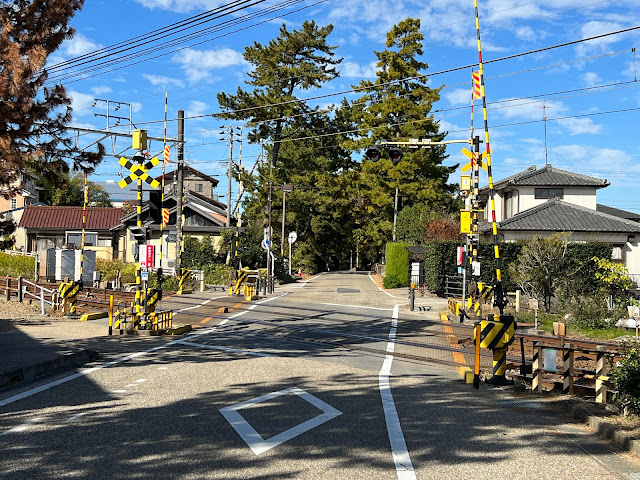The day dawned overcast and proper chilly – I wore a beanie for most of the morning – but without yesterday’s bracing wind it warmed up appreciably through the day as the clouds disappeared.
Two Meitetsu-line trains in their smart crimson livery took me back to the unstaffed little station at Nagasawa to pick up the Old Tokaido:
A little roadside shrine held a statue of a Buddha (I think), a few coins, a single-serve sake bottle on its side and a sake cup. I added 10 yen towards the next drink.
The Old Tokaido and Route 1 performed their by-now familiar dance: sometimes sharing the same space; sometimes weaving in and out but generally never too far away from each other. The road rose gently towards a crest and I crossed into Okazaki City:
At one of the points where the OT branched off from the modern trunk route and into local back streets, I saw I sign I’d not noticed before:
In the blue circle it reads, “sirubarodo” – literally “silver road”, as in, people with silver hair – ie, seniors. Underneath it says, “Be careful of the elderly”. I hoped motorists would take note.
This photo of Hotel Antoinette didn’t come out very well:
At first I thought it was a love hotel but then I noticed that it advertised itself as a “spa and resort”. Somehow that didn’t make it any more appealing. I hope they serve cake for afternoon tea though.
Fujikawa was one of the larger post towns on this section of the Tokaido, and at the entrance to the town there’s the obligatory reproduction of the relevant Hiroshige print:
This one apparently shows the procession of the annual gift of horses from the Emperor in Kyoto to the Shogun in Edo entering the Fujikawa barrier from the right, while the townsfolk adopt appropriately grovelling attitudes on the left. I like the way that Hiroshige gives each of the commoners a distinct personality, while the Imperial procession is almost entirely anonymous.
Here’s the modern reconstruction of part of the same barrier:
This narrow alley leading off the main street in the middle of Fujikawa gives a sense of the old town:
At the western end of the road through Fujikawa there’s a really nice avenue of pines beyond a level crossing:
Just after taking that photo, light began to flash and sirens began to wail, and the barriers came down. Under the pretence of taking a picture of the passing train, I snapped this tiny single-person electric car. Very practical in the narrow back streets of Japanese towns and villages.
Rejoining Route 1, a T Rex presided over a scrap metal yard:
A little further on, there’s a good reconstruction of an ichirizuka – the tree planted on top of a mound every 4 km or so. Apparently this one dates from 1928.
The Tokaido’s path through the castle town of Okazaki is famous for the number of right-angle turns it takes – 27 in all – in a bid to thwart would-be attackers. Although the route through the modern town is shown in my guide book, the scale of the map makes it hard to work out exactly which road to take. In places the turns are indicated with signposts (this one reads, “Tokaido Okazaki Castle 27 turns”):
… but in many spots it’s left to guesswork and best estimation. I think I got most of it right, but definitely ended up on a parallel street at one point.
Eventually, just before crossing the Yahagi River, the Tokaido enters an old district where miso is still made in the traditional way, in traditional buildings. This is one of them:
Unfortunately, what I assume is a shop behind the noren curtain was closed.
Over the bridge, and time to rest and work out my destination for the day. As I was studying the guidebook, two women approached and, seeing what was on the cover, asked which bit of the Tokaido I was walking. I showed them my introduction, and they expressed amazement and asked why I was walking the whole way from Tokyo to Kyoto. At this point I had to fall back on Google translate, and so we went back and forth speaking into the mic and reading the translation. They seemed impressed that an outsider was interested in seeing the ‘real’ Japan, away from the usual tourist spots. “Everyone,” I managed to say in Japanese, “goes to Tokyo. Everyone goes to Kyoto. No one comes here!” This was especially appreciated. Eventually, with the usual profuse thanks and “ganbatte!” and bowing, we parted, but not before they very kindly agreed to let me take their photograph.
So, thank you Tomoko-san (left) and Misa-san. Definitely a highlight of the day.
The final few kilometres on to Shin-Anjo station were far less engaging. The light was fading and so was I, and it was a relief to catch the train onwards to Kanayama and my hotel.
But I couldn’t resist photographing this typical bit of modern Tokaido landscape:
Route 1 curves around to the left; the Tokaido carries straight on through its avenue of pines. I believe the McDonald’s (dead centre of the photo_ may not have been there in Hiroshige’s time…

















Comments
Post a Comment